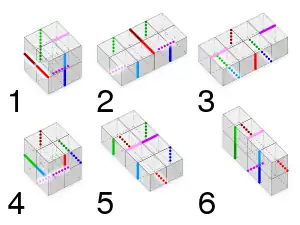

An Infinity cube is a kind of mechanical puzzle toy with mathematical principles. Its shape is similar to a 2×2 Rubik's cube. It can be opened and put back together from different directions, thus creating a visually interesting effect.
Construction

The principle of the infinity cube is simple and can be made by hand with simple paper cutting and pasting. First make 8 small cubes, then arrange the small cubes in a 2 by 2 by 2 way, and tape 8 edges together. When combined, there are 28 small squares exposed and 20 small squares hidden inside.
Mathematics
Like the Rubik's Cube, the various states of the Infinity Cube can be represented as a group, but the Infinity Cube has far fewer permutations than the Rubik's Cube.
Rubik's Cube group have permutations[1][2] and isomorphic to the below groupware are alternating groups and are cyclic groups:
The largest group representation for Infinity Cube only contains 6 elements, and can be represented as:
See also
References
- ↑ Schönert, Martin. "Analyzing Rubik's Cube with GAP".
- ↑ Tom Davis, "Rubik's Cube. Part II", p.23 in, Zvezdelina Stankova, Tom Rike (eds), A Decade of the Berkeley Math Circle, American Mathematical Society, 2015 ISBN 9780821849125.